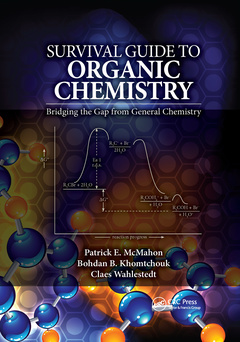Description
Survival Guide to Organic Chemistry
Bridging the Gap from General Chemistry
Authors: McMahon Patrick E., Khomtchouk Bohdan B., Wahlestedt Claes
Language: English
Subjects for Survival Guide to Organic Chemistry:
Keywords
Constitutional Isomer; Bridging the gap between general and organic chemistry; Lewis Structures; Organic chemistry I and II; Electrophilic Addition; Lone Pair; Teaching organic chemistry through drawing molecules; Neighboring Carbon; Organic nomenclature; Alkyl Halides; Organic Molecule Isomers; CH2 CH CHCH2; Carbon Cation; Central Atoms; Leaving Group; Nucleophilic Atom; Bond Lines; CH CH CH CH3; Multiple Bond; Bond Axis; Ring Carbon; Stereoisomer Products; Line Drawing; Double Bond; Lone Electron Pairs; Reaction Step; Axis Carbon; R2C CR2; Tetrahedral Intermediate; Chiral Carbon
57.55 €
In Print (Delivery period: 14 days).
Add to cartPublication date: 06-2022
Support: Print on demand
160.25 €
In Print (Delivery period: 15 days).
Add to cartPublication date: 12-2016
· 17.8x25.4 cm · Hardback
Description
/li>Contents
/li>Biography
/li>
The Survival Guide to Organic Chemistry: Bridging the Gap from General Chemistry enables organic chemistry students to bridge the gap between general chemistry and organic chemistry. It makes sense of the myriad of in-depth concepts of organic chemistry, without overwhelming them in the necessary detail often given in a complete organic chemistry text.
Here, the topics covered span the entire standard organic chemistry curriculum. The authors describe subjects which require further explanation, offer alternate viewpoints for understanding and provide hands-on practical problems and solutions to help master the material. This text ultimately allows students to apply key ideas from their general chemistry curriculum to key concepts in organic chemistry.
Key Features:
Chapter 1: General Concepts for Covalent Bonding and Constructing Lewis Structures for Organic Molecules. Chapter 2: Guideline for Writing Organic Molecule Isomers and Determining Number of Rings Plus Pi-Bonds. Chapter 3: Guideline for Complete Analysis for Central Atoms and Molecules: Bonding/Hybridization/Geometry/Polarity. Chapter 4: Notation in Organic Chemistry: Guide to Writing and Using Condensed Formulas and Line Drawings. Chapter 5: Summary Guidelines for Organic Nomenclature. Chapter 6: Guidelines for Analysis of Intermolecular Forces for Organic Molecules. Chapter 7: Alkane and Cycloalkane Conformations. Chapter 8: Summary Guide to Thermodynamic Concepts for Organic Chemistry. Chapter 9: Guide to Kinetics and Reaction Mechanisms. Chapter 10: Review of Acid/Base Concepts for Organic Chemistry. Chapter 11: Electrophiles and Nucleophiles in Organic Reaction Mechanisms. Chapter 12: Conceptual Guide to Mechanisms in Organic Chemistry. Chapter 13: Guide to Stereochemistry Concepts and Analysis of Reaction Stereochemistry as Applied to Electrophilic Addition. Chapter 14: A Process for Calculation of Product Distribution Through Relative Rate Analysis: Examples for Free Radical Halogenation. Chapter 15: Process to Identify and Solve the Reactions for Organic I. Chapter 16: Electrophilic Addition and Addition/Elimination to Conjugated Double Bond and Aromatic Systems. Chapter 17: Oxidation/Reduction Relationships for Carbonyl Carbon. Chapter 18: A Complete System for Organizing, Identifying, and Solving Carbonyl Reactions: Nucleophilic Addition and Addition/Elimination. Chapter 19: A Brief Guideline for Applying Fundamental Concepts in NMR Spectroscopy. Organic I Practice Exams. Organic II Practice Exams. Multiple Choice Exams.
Patrick E. McMahon has for the past twenty three years been teaching both general chemistry and organic chemistry at Benedictine University in Lisle, Illinois. Prior to that, he was a research scientist for Amoco Chemical Company at the Naperville, Illinois campus. McMahon has also taught at several institutions in the Chicago area, including Elmhurst College, Dominican University and Triton Community College. He is a member of the American Legion and served in the United States Army from 1970-1972. His main area of research interest is organic reaction catalysis. Awards that can be accredited to his name include the B.J. Babler award for outstanding contribution to under-graduate instruction at the University of Illinois, the Dean’s Award for Teaching Excellence at Benedictine University and first recipient of the Shining Star award given by the student senate for outstanding contribution to students at Benedictine University.
Bohdan B. Khomtchouk is a triple-major summa cum laude (B.Sc. Biochemistry and Molecular Biology, B.Sc. Mathematics and B.Sc. Physics) and is currently United States Department of Defense NDSEG Fellow at the University of Miami Miller School of Medicine.
Claes Wahlestedt, MD, PhD, is Leonard M. Miller Professor at the University of Miami Miller School of Medicine and is working on a range of chemistry related translational efforts in his roles as Associate Dean and Center Director for Therapeutic Innovation. The author of some 250 peer reviewed scientific publications with 30,000+ citations, his ongoing research projects concern chemical biology, epigenetics, genomics and drug/biomarker discovery across several therapeutic areas. He has experience not only from academia, but also from leadership positions in the pharmaceutical industry, namely Astra-Zeneca, Pharmacia & Upjohn and Pharmacia Corporation.




